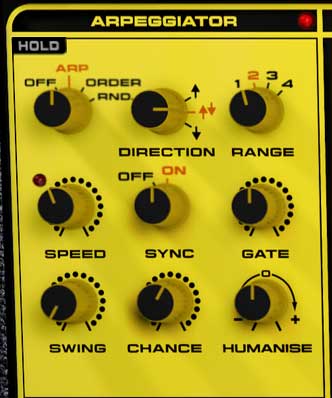
An arpeggiator is essentially a step sequencer that plays each note of a chord individually in an ascending or descending pattern across one or more octaves.
Hold- When engaged, arpeggios continue to run without having to continuously hold down keys. This allows you to play a series of chords without the arpeggiator stopping as keys are released. Be aware that it will not stop until you disengage the button again. Mapping this to a sustain pedal or button on a MIDI controller can be useful for conveniently toggling arpeggio playback on and off.
Mode switch-
Off- Arpeggiator is disabled. The LED next to ARPEGGIATOR name illuminates when the it's active.
Arp- Plays notes according to the Direction control setting.
Order- Plays the notes in the order they are pressed dependent on current Direction setting. (trying really hard not to make a dumb One Direction joke here. Are they even famous anymore?)
Up- Notes sound in original order played.
Down- Notes sound in the reverse order they were played.
Up/Down- Notes sound in original order played followed by reverse order played. Tricky, right?
Random- Plays held notes in random order.
Direction- The Direction control functionality varies a bit depending on the current position of the Mode switch as follows:
Mode Switch set to Arp- Selects up, up/down, or down note playback.
Mode Switch set to Order- See Order section above.
Mode Switch set to Rnd.- Direction control doesn't do anything. Control is dimmed and disabled.
Range- Selects how many octaves the pattern will play before repeating.
Speed- Sets the pattern speed playback speed from 0.25 to 30 Hz. The LED flashes to indicate the current speed.
Sync- Engaging the Sync control locks arpeggio timing to master tempo. When engaged, the Speed knob snaps to note values ranging from 1/64th note triplet to 8 beats. Sync mode locks to the tempo in the top toolbar when using the Yellowjacket standalone version or the current project tempo when the plug-in version is used in a DAW.
Gate- Sets the length of time note gates are held relative to the current speed. 50% is the default setting, i.e. half of the current Speed setting.
Swing- Delays every other note played by percentage defined by knob setting. Leave Swing at zero for straight time.
Chance- Sets the probability of a note sounding on a given step. This setting can also create random note breaks in the arp sequence, which, when combined with multiple arp tracks within a DAW, can produce unique, evolving poly-rhythms. By default, leave it up at 100% for notes to sound on every arpeggio step. At a minimum, there is a 30% chance that a note will sound on a given step.
Humanise- Adds a degree of randomness to arpeggio pattern timing. Positive values cause notes to play after the beat; negative values cause notes to play before the beat. When used in a DAW, Humanize can push or pull the arpeggio behind or forward of the beat to create engaging grooves. Use your DAW's parameter recorder to vary the amount, swinging from pull to push per bar for a more human response.
Additional Note- As mentioned previously, the Arpeggiator can be combined with the Keyboard Cycle modes and Scales to provide varied patterns, even with the touch of a single key. By individually tuning the pitch of the different Multi Mode Voice Panel synthesizers in Multi Cycle mode, for instance, the arpeggiator effectively becomes a transposable four-note step sequencer. See the Yellowjacket presets "Cheap Arp" and "Dream Sequence" for examples of this. Yellowjacket can yield surprisingly effective and diverse results with each pass when combined with other arpeggiator features such as Chance and Humanise.